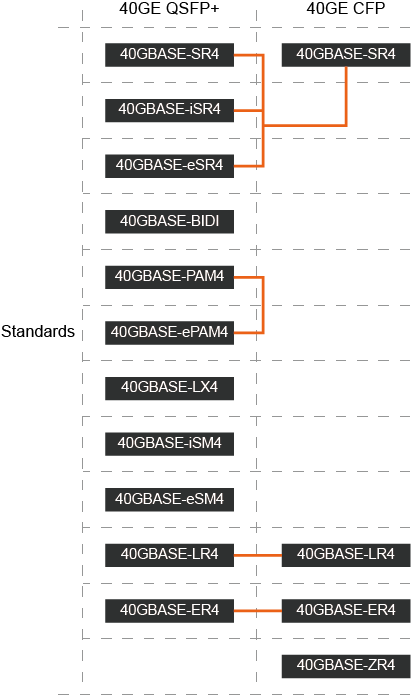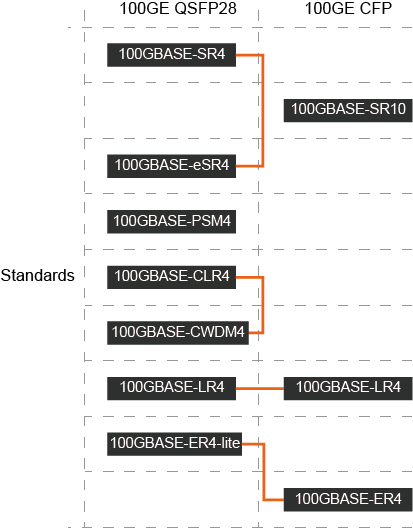Rules for Optical Module Interoperation
Interoperation Rules
Optical modules with the same standards can interoperate with each other. The standards define the rate, wavelength, and transmission distance of optical modules, but not their encapsulation modes (two interoperated optical modules can have different encapsulation modes).
If you need to achieve interoperability between optical modules with different standards, contact technical support personnel.
When Huawei switches are connected to other products such as routers, comply with the preceding optical module interoperation rules.
Standards Description
The following describes the standards, using 1000BASE-LX10 as an example:
- 1000 indicates the rate (1000 Mbit/s, in this case). Other rates include 10 Mbit/s, 100 Mbit/s, 10 Gbit/s, 40 Gbit/s, and 100 Gbit/s.
- BASE indicates baseband transmission.
- L represents a center wavelength of the laser. Currently, the following center wavelengths are available: S (short wavelength: 850 nm), L (long wavelength: 1310 nm), E (extra long wavelength: 1550 nm), and B (single-fiber bidirectional long wavelength).
- X represents the encoding format. The encoding formats include T (twisted pair), X (8B/10B), R (64B/66B), and W (WIS).
- 10 indicates the number of channels. Currently, the value can be 4 or 10. If there is no number, the value is 1.

This example provides the definitions in IEEE standards, which are not applicable to all optical modules, for example, non-standard optical modules.
- IEEE 802.3, which defines MAC and PHY standards
- Small Form Factor (SFF) committee or Multi-Source Agreements (MSAs), which define optical module hardware, software, and structure standards
Interoperability of 40GE and 100GE Optical Modules
Huawei S series switches support the following types of 40GE and 100GE optical modules:
- 40GE QSFP+ optical modules
- 40GE CFP optical modules
- 100GE CFP optical modules
- 100GE QSFP28 optical modules



Optical modules complying with the standards connected in the preceding figures can interoperate with each other.
iSR4 and eSR4 are non-standard formats derived from SR4, and support interoperation with SR4.
A 40GBASE-PAM4 optical module can interoperate with a 40GBASE-ePAM4 optical module.
A 100GBASE-CLR4 optical module can interoperate with a 100GBASE-CWDM4 optical module.
A 100GBASE-ER4-lite optical module can interoperate with a 100GBASE-ER4 optical module, at a maximum distance of 30 km.